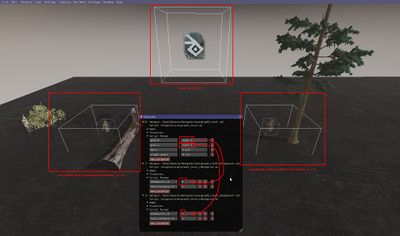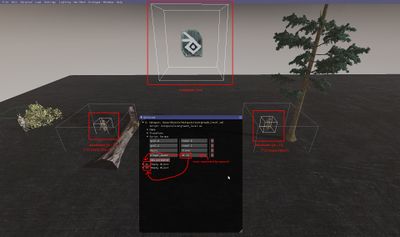Checkpoints
Checkpoints allow you to set up goals that the player can achieve to advance progress in a level.
With them you can move the player spawn point upon death and allow defeated enemies to remain dead.
When the player advances progress, you can do nothing, play a dialogue, spawn new enemies, or trigger a level win (load the next level).
You can make some of the checkpoints optional, so player progress is saved, but the player does not have to touch them to complete the level.
TODO: Need to add other goal types, there are a couple more that have been added to overgrowth_level.
TODO: Need to add other goal achievement actions, there are several more that have been added to overgrowth_level.
TODO: Add some screenshots to make this more clear?
Contents
Using the checkpoint system
Start by creating a new level, or opening an existing level, and activating the editor by hitting F1.
You might want to enable debug text (Settings -> Debug -> enable Draw In-Game Debug Window).
Debug keys (these will work once a level has checkpoints):
| L | reset the level to the currently achieved checkpoint |
| K | swap to the next checkpoint, or wrap around to the first (remember to hit L after to reset) |
To add the checkpoint system to a level:
Load -> Load Item... -> Data/Objects/Hotspots/overgrowth_level.xml
The table below shows the types of goals that can be used as checkpoints. Below the table are instructions for how to use each goal.
| reach | when touched, moves the player spawn point and saves defeated enemies. must touch it to complete the level/advance progress |
| reach_skippable | same as "reach" goal but the player never has to reach it to complete the level/advance progress |
| defeat | the player must defeat a list of enemies to complete the level/advance progress |
| defeat_optional | the player may defeat a list of enemies to advance progress. If a further goal is accomplished first, these enemies are considered "defeated" when the character respawns |
| spawn_defeat | same as "defeat" goal but the enemies to defeat are spawned when that becomes the current goal (or on reset) |
| no_delay | this is a modifier you can put after any defeat goal, to reduce the time to the current goal_post or next goal_pre being triggered |
reach goal
- Add the checkpoint hotspot to the scene. This is the trigger for the checkpoint. Load -> Load Item... ->
Data/Objects/Hotspots/overgrowth_level_checkpoint.xml - Add the placeholder object to the scene. This is the player spawn. Load -> Utility -> Placeholder
- Set the checkpoint hotspot
checkpoint_idparameter to a value starting at0and increasing by 1 for each checkpoint you add - Set the checkpoint hotspot
level_hotspot_idparameter to the object id of the overgrowth_level hotspot - Add a
goal_<number>parameter to the overgrowth_level hotspot and set the value toreach <number>, with the number from step 3 - Add a value to the overgrowth_level hotspot
player_spawnparameter, delimited with spaces, with the id of the placeholder object from step 2 (437 243 121). The order matters, and the id for checkpoint 0 should go in the first spot, checkpoint 1 in the second spot, etc. You can see that you've written the correct ID if a transparent character model appears in the placeholder hotspot.
The numbers in checkpoints are tricky to get right. To add an additional checkpoint:
- Add another goal param to the overgrowth_level hotspot, and give it a number one higher than the previous goal. So if your previous goal was
goal_0, you would add another one with the namegoal_1 - Set the goal param's value to one higher than the previous goal. So if the previous one was
reach 5, this new param's value would bereach 6 - Load a checkpoint object, and set its
checkpoint_idparameter to a value that matches the reach goal in step #2. So, if the goal isreach 6, then this would just be6 - Set the checkpoint object's
level_hotspot_idparam - Load a placeholder object for the player to spawn at
- Add the id of the placeholder object to the end of the overgrowth_level's
player_spawnparam. So if it was previously123 456then it would now be something like123 456 784
reach_skippable goal
Do all the same as a "reach" hotspot, but in step 5 set the value to reach_skippable <number> instead of reach <number>
defeat goal
- Add an enemy to the level
- Add a
goal_<number>parameter to the overgrowth_level hotspot and set the value todefeat <number>, with the object id of the enemy from step 1 - Add additional enemy ids in the form of
defeat <some_enemy_id> <other_enemy_id>, just like in step two (e.g.defeat 4 72 8)
defeat_optional goal
Do all the same as a defeat goal, but in step 2 set the value to defeat_optional <numbers...> instead of defeat <numbers...>
spawn_defeat goal
Do all the same as a defeat goal, but in step 2 set the value to spawn_defeat <numbers...> instead of defeat <numbers...>
Triggering effects before/after goals
You can trigger an action to happen, either when a goal is set as the "current" goal, or after a goal has been accomplished.
Here's a list of actions that can be triggered:
music_layer_override <N>
| activate | make a character with the given id active. This removes the "static" flag from the character. Useful for reducing CPU utilization for characters you haven't reached yet |
| enable | enable a game object with the given id. This can be any object type, not just a character. This will make it appear in game and activate its behavior |
| disable | disable a game object with the given id. This can be any object type, not just a character. This will make it disappear in game and deactivate its behavior |
| dialogue | play a dialogue with the given dialogue name |
| dialogue_fade | same as dialogue action but the dialogue is faded in/out at the beginning and end (except on reset). Useful to make dialogue "teleportation" feel less jarring
|
| dialogue_fade_if_not_hostile | same as dialogue_fade action but the dialogue is not triggered at all if you're currently still in combat (TODO: Not sure why this is useful?)
|
| play_success_sting | play the success music track, since this was a particularly challenging goal. Usually done on a goal_N_post action
|
| music_layer_override | force play of the given music track layer. Set to the appropriate layer number to force a certain layer to be played. Set to -1 to let the game select based on the activity level. Set to -2 for silence (TODO: Is this correct for -2?)
|
TODO: Redo the rest of this to describe each type
To trigger a dialogue just before starting on a new goal (whether a "reach" or "defeat" goal):
- Add a dialogue to the level and get it working with the dialogue editor
- Add a
goal_<number>_preparameter to the overgrowth_level hotspot and set the value todialogue <dialoguename>, with the dialogue name from step 1, and the number of the goal you want the dialogue to be triggered before. (e.g.goal_5_pre) - Note that the dialogue will be started again if you die and respawn, and the dialogue can be used to set a new spawn point for the player
To trigger a dialogue just after achieving a checkpoint goal (whether a "reach" or "defeat" checkpoint):
Do all the same as a dialogue triggered before progressing to a given checkpoint, but name the parameter goal_<number>_post (e.g. goal_5_post)
Troubleshooting
General
Make sure you don't use a start_dialogue hotspot on top of the player's spawn. Doing this will likely break the checkpoint system.
If you need to start a dialogue at the beginning of the level, use a goal_0_pre instead, with a value of dialogue "dialogue name here". Make sure you're setting the dialogue's name in the dialogue editor, and not in the script params or "Selected" window.
overgrowth_level_checkpoint
Open up all of your overgrowth_level_checkpoint instances, and look at the script parameters for them.
- Make sure that
checkpoint_idstarts at zero, and increases by 1 (and only by 1) for each subsequent checkpoint. This will be true even if the firstreachgoal isn'tgoal_0! - Make sure that
reach Nvalues match the values forcheckpoint_id.
overgrowth_level
Open up the script parameters for the overgrowth_level instance, and look at the script parameters.
- The goals should start at
goal_0, not atgoal_1. - Look at the
player_spawnproperty. Count up the number of Ids in there (separated with spaces), and count up the number ofreachgoals you have. Those should be the same count. - Make sure that each
player_spawnid corresponds to a placeholder object in the world, and that you see a turner in a T-Pose inside each of them (which means that you typed them correctly in theplayer_spawnfield).

